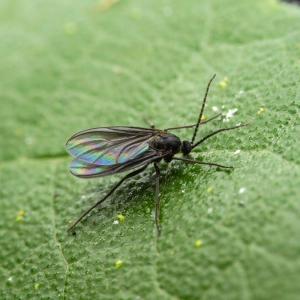Sciarid flies cause most damage to plants by transferring fungal diseases from diseased to healthy plants. But it is the larvae that cause the real damage to plants by feeding on the roots, root hairs, rootlets, and tender root, stem and leaf tissue. Later instars may even feed on plant stems.
Young plants that are kept humid and well-watered are particularly at risk as sciarid flies thrive in damp compost.
House plants are common targets of the sciriad fly, as are cyclamen, fuchsia, pelargonium and poinsettia. Sciarid flies can be a nuisance indoors as they fly around pot plants and plants in greenhouses and conservatories.
Identifying Sciarid Fly Damage
The main impacts of sciarid fly larvae damage are poor plant health, wilting (particularly on hot days) and at times, total plant death. Young plants are more susceptible to damage than older established ones.
On some plants, larvae may feed on leaves that rest on the soil – this can cause holes to appear in leaves which may look similar to the damage caused by slugs.
Using sticky traps can quickly identify a sciarid fly problem and help you identify the extent of the infestation - as the flies show up easily against the traps. However, the traps won’t entirely get rid of the problem if the larvae remain in the soil.
How to get rid of sciarid flies
To tackle the problems caused by a sciarid population, you need to get rid of the larvae in the soil. Exposing the roots of potted plants, disposing of the soil and then repotting in fresh clean compost can help, but it is likely that the larvae will remain tangled in the roots, so this method isn’t always successful.
To eradicate the larvae, use predator nematodes – a natural chemical-free solution. Our sciarid fly control contains the insect parasitic nematodes Steinernema feltiae. After applying the nematodes, they will actively search for and penetrate the sciarid fly larvae. They then excrete bacteria, killing the larvae. The nematode will then go on to seek out more, repeating the cycle.
Biological sciarid control is a highly effective, safe treatment that can be used on turf as well as ornamentals. It is safe for pets and other wildlife and the perfect choice for organic gardeners.
How to use nematodes to control sciarid fly larvae
You can apply these nematodes to the compost of indoor house plants at any time of year. They are UV-sensitive, so it is best to avoid applying them to plants that are in direct sunlight – move the plant to the shade before applying nematodes.
You apply nematodes by dissolving the pack contents in a bucket of water to create a stock solution. You then further dilute some of this stock solution in more water in a watering can. Specific dilution and application rates are shown on our product page and depend on what size pack coverage you select.
Once you have the stock correctly diluted, you simply pour the solution directly onto the soil around the affected plants. This application will tackle larvae in the soil.
Storing nematodes
Nematodes are perishable, so they should be used immediately after receipt. If you cannot apply them on the day of receipt, you can refrigerate them and used by the expiry date. Make sure you remove the outer packaging to allow air to circulate.
Use the entire pack and do not store stock solution or diluted product.
Please note that delivery of all biological controls can take up to two weeks. It is advisable to make sure someone will be at home to receive the parcel as nematodes are a living organism and should not be left on doorsteps!




